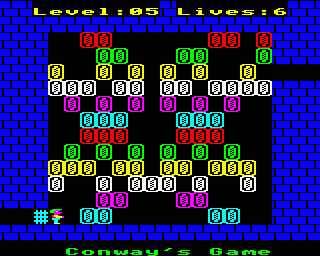
So Simple
Mazezam is the latest spawn of the Retro Software team, and is Kian Vincent's conversion to the BBC and Electron of a puzzle game for the Spectrum by Malcolm Tyrell. It's one of these games that has rules so simple that your grandad could play it - but stimulates the areas of your brain that the typical arcade game does not reach.
You are placed in a room which is solidly bordered on all sides - i.e. within a square or a rectangle - and the different rooms have different sizes of rectangle. As you enter each room, a gate closes behind you to signal that your new challenge awaits. It's a case of onward, ever onward. Were the squares completely empty of course there would be no challenge. Naturally enough they are not.
They are filled with blocks which bar the way to the exit on the opposite side of the screen. This being a puzzle game, the blocks are in fact your only nemesis. No patrolling nasties or anything - just blocks that you can push around.
Now the blocks are not divisible entities. In fact all the blocks on one 'row' are connected. You can tell this because they are all the same colour. Because Mazezam is a Mode 2 game as well, you often get rows of all seven colours, which is jolly nice. If you push one block, the whole row shifts - not just the block you're pushing. So to get into the maze of blocks you pay have to push a block right on a row where the same push sends another to obstruct the exit. The trick is to try and think some ten, or on later levels 15-20, moves ahead. It is like trying to pick your way through a maze of constantly shifting walls but where you are ultimately responsible for which way the maze moves - and of course whether you end up in an inescapable dead end.
Ever Increasing Difficulty
There's a steadily difficulty curve. I have always been quite good at these types of puzzle games (I'm not quite sure why but if you're wondering what 'type' of game I mean, think of games like Push The Bale!) and got through the first seven levels by applying my brain and proceeding carefully. However, level eight has me somewhat foxed at the moment. There are some 31 levels after this leads to me to think the player must be up against some incredibly devious maze designs in the future.
The keys are the regular ZX*? ones and the whole game is done in smooth machine-code. The sprites are limited (to designs of you and the blocks) - but a game like Mazezam doesn't really suffer because of this, and the range of colours on offer offset this limitation. It's also handy that you're equipped with a large number of lives (eight) and that the ESCAPE key restarts the current room rather than quits the whole game (To do this use Q).
Verdict
The simplicity of the game itself means that there's not actually a lot more to say about it. It reminds me of the type of game that was hidden away on the old Micro User/Acorn Computing cover discs of the early Nineties. I wouldn't say it's as addictive as some other simplistic games (Tetris and Tactic spring to mind!), but it's an idea I haven't seen done on the BBC and Electron previously; and getting to the exit of each maze is extremely satisfying. What would have been great would have been if Vincent had included passwords, or at least a feature to start a new game on the most recent level a player had reached. It's no fun having to replay all the earlier levels once those nine lives do finally run out!
An inspiring and entertaining game, certain to appeal to puzzle fans.